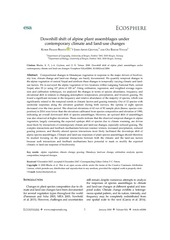| dc.contributor.author | Bhatta, Kuber Prasad | |
| dc.contributor.author | Grytnes, John-Arvid | |
| dc.contributor.author | Vetaas, Ole Reidar | |
| dc.date.accessioned | 2018-08-31T07:53:37Z | |
| dc.date.available | 2018-08-31T07:53:37Z | |
| dc.date.issued | 2018-01-10 | |
| dc.identifier.issn | 2150-8925 | |
| dc.identifier.uri | https://hdl.handle.net/1956/18338 | |
| dc.description.abstract | Compositional changes in Himalayan vegetation in response to the major drivers of biodiver- sity loss, climate change and land-use change, are barely documented. We quantify temporal changes in the alpine vegetation of central Nepal and attribute these changes to temporally varying climatic and land- use factors. We re-surveyed the alpine vegetation of two locations within Langtang National Park, central Nepal, after 25 yr using 127 plots of 100 m2. Using ordination, regression, and weighted average regres- sion and calibration techniques, we analyzed the changes in terms of species abundance, frequency, and elevational shift in relation to changing atmospheric temperature, precipitation, and livestock grazing. We found a significant increase in the frequency and relative abundance of the majority of species, which was significantly related to the temporal trends in climatic factors and grazing intensity. Out of 12 species with unimodal responses along the elevation gradient during both surveys, the optima of eight species decreased over the time period. The observed elevations of 62 out of 92 sample plots (hence, species com- position) in 2014 were lower than the elevations calibrated from species composition and elevation of 1990, indicating an overall downward shift of species assemblages. However, an upward shift of assemblages was also observed at higher elevations. These results indicate that the observed temporal changes in alpine vegetation, largely contrasting the expected upslope shift of species due to climate warming, are driven most likely by interactions of contemporary climate and land-use changes, especially reduced grazing. The complex interactions and feedback mechanisms between warmer winters, increased precipitation, reduced grazing pressure, and thereby altered species interactions most likely facilitated the downslope shift of alpine species assemblages. Climatic and land-use responses of plant species assemblages should therefore be studied focusing on the potential interactions between both the climatic and the land-use factors because such interactions and feedback mechanisms have potential to mask or modify the expected climatic or land-use response of biodiversity. | en_US |
| dc.language.iso | eng | eng |
| dc.publisher | Ecological Society of America | eng |
| dc.relation.ispartof | <a href="http://hdl.handle.net/1956/18338" target="blank">Spatiotemporal dynamics of plant assemblages under changing climate and land-use regimes in central Nepal Himalaya</a> | |
| dc.rights | This is an open access article under the terms of the Creative Commons Attribution License, which permits use, distribution and reproduction in any medium, provided the original work is properly cited. | eng |
| dc.rights.uri | https://creativecommons.org/licenses/by/3.0/ | eng |
| dc.subject | alpine vegetation | eng |
| dc.subject | climate change | eng |
| dc.subject | grazing | eng |
| dc.subject | Himalaya | eng |
| dc.subject | land-use change | eng |
| dc.subject | ordination analysis | eng |
| dc.subject | species composition | eng |
| dc.subject | temporal changes | eng |
| dc.title | Downhill shift of alpine plant assemblages under contemporary climate and land-use changes | eng |
| dc.type | Peer reviewed | en_US |
| dc.type | Journal article | en_US |
| dc.description.version | publishedVersion | |
| dc.rights.holder | © 2018 Bhatta et al. | en_US |
| dc.source.articlenumber | e02084 | |
| dc.identifier.doi | https://doi.org/10.1002/ecs2.2084 | |
| dc.source.journal | Ecosphere | |
| dc.source.40 | 9 | |
| dc.source.14 | 1 | |
| dc.subject.nsi | VDP::Matematikk og Naturvitenskap: 400::Geofag: 450 | no |
| dc.identifier.citation | Ecosphere. 2018, 9 (1), e02084. | |

